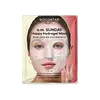What's inside
What's inside
 Key Ingredients
Key Ingredients

 Benefits
Benefits

 Concerns
Concerns

 Ingredients Side-by-side
Ingredients Side-by-side

Collagen Water
HumectantGlycerin
HumectantCetyl Ethylhexanoate
EmollientNiacinamide
Smoothing1,2-Hexanediol
Skin ConditioningChondrus Crispus Powder
AbrasiveCeratonia Siliqua Gum
EmollientCaprylic/Capric Triglyceride
MaskingXanthan Gum
EmulsifyingWater
Skin ConditioningPhenoxyethanol
PreservativePanthenol
Skin ConditioningPEG-60 Hydrogenated Castor Oil
EmulsifyingChlorphenesin
AntimicrobialCyamopsis Tetragonoloba Gum
Emulsion StabilisingAgar
MaskingTocopheryl Acetate
AntioxidantAllantoin
Skin ConditioningPotassium Chloride
Glucose
HumectantButylene Glycol
HumectantAdenosine
Skin ConditioningCollagen Extract
Skin ConditioningDisodium EDTA
Artemisia Vulgaris Oil
PerfumingCopaifera Officinalis Resin
MaskingMentha Viridis Leaf Oil
AstringentDipotassium Glycyrrhizate
HumectantSodium Hyaluronate
HumectantUndaria Pinnatifida Extract
Skin ConditioningCodium Tomentosum Extract
Skin ProtectingEnteromorpha Compressa Extract
Skin ProtectingLaminaria Japonica Extract
Skin ProtectingSalicornia Herbacea Extract
Skin ConditioningAspergillus Ferment
Skin ConditioningSaccharomyces Ferment Filtrate
HumectantGalactomyces Ferment Filtrate
HumectantLeuconostoc/Radish Root Ferment Filtrate
AntimicrobialLactobacillus Ferment Lysate
Skin ConditioningLactococcus Ferment Lysate
Skin ConditioningBeta-Glucan
Skin ConditioningTocopherol
AntioxidantCollagen Water, Glycerin, Cetyl Ethylhexanoate, Niacinamide, 1,2-Hexanediol, Chondrus Crispus Powder, Ceratonia Siliqua Gum, Caprylic/Capric Triglyceride, Xanthan Gum, Water, Phenoxyethanol, Panthenol, PEG-60 Hydrogenated Castor Oil, Chlorphenesin, Cyamopsis Tetragonoloba Gum, Agar, Tocopheryl Acetate, Allantoin, Potassium Chloride, Glucose, Butylene Glycol, Adenosine, Collagen Extract, Disodium EDTA, Artemisia Vulgaris Oil, Copaifera Officinalis Resin, Mentha Viridis Leaf Oil, Dipotassium Glycyrrhizate, Sodium Hyaluronate, Undaria Pinnatifida Extract, Codium Tomentosum Extract, Enteromorpha Compressa Extract, Laminaria Japonica Extract, Salicornia Herbacea Extract, Aspergillus Ferment, Saccharomyces Ferment Filtrate, Galactomyces Ferment Filtrate, Leuconostoc/Radish Root Ferment Filtrate, Lactobacillus Ferment Lysate, Lactococcus Ferment Lysate, Beta-Glucan, Tocopherol
Water
Skin ConditioningGlycerin
HumectantDipropylene Glycol
HumectantChondrus Crispus Powder
AbrasiveCeratonia Siliqua Gum
EmollientXanthan Gum
EmulsifyingPhenoxyethanol
PreservativePEG-60 Hydrogenated Castor Oil
EmulsifyingRicinus Communis Seed Oil
MaskingPanthenol
Skin ConditioningChlorphenesin
AntimicrobialAllantoin
Skin ConditioningButylene Glycol
HumectantPrunus Persica Fruit Extract
AbrasiveAgar
MaskingCyamopsis Tetragonoloba Gum
Emulsion StabilisingPrunus Serrulata Flower Extract
Skin ConditioningParfum
MaskingCalcium Lactate
AstringentPotassium Chloride
Glucose
HumectantTocopheryl Acetate
AntioxidantDisodium EDTA
CI 77491
Cosmetic ColorantAloe Barbadensis Leaf Juice Powder
Skin Conditioning1,2-Hexanediol
Skin ConditioningSodium Hyaluronate
HumectantMaltodextrin
AbsorbentLactobacillus/Soybean Ferment Extract
Skin ConditioningFreesia Refracta Extract
Skin ConditioningMentha Piperita Leaf Extract
Skin ConditioningChamomilla Recutita Flower/Leaf Extract
AntimicrobialDioscorea Japonica Root Extract
Skin ConditioningMonarda Didyma Leaf Extract
Skin ConditioningRosmarinus Officinalis Leaf Extract
AntimicrobialLavandula Angustifolia Extract
Skin ConditioningTremella Fuciformis Extract
HumectantEthylhexylglycerin
Skin ConditioningHydrolyzed Coral
Skin ConditioningWater, Glycerin, Dipropylene Glycol, Chondrus Crispus Powder, Ceratonia Siliqua Gum, Xanthan Gum, Phenoxyethanol, PEG-60 Hydrogenated Castor Oil, Ricinus Communis Seed Oil, Panthenol, Chlorphenesin, Allantoin, Butylene Glycol, Prunus Persica Fruit Extract, Agar, Cyamopsis Tetragonoloba Gum, Prunus Serrulata Flower Extract, Parfum, Calcium Lactate, Potassium Chloride, Glucose, Tocopheryl Acetate, Disodium EDTA, CI 77491, Aloe Barbadensis Leaf Juice Powder, 1,2-Hexanediol, Sodium Hyaluronate, Maltodextrin, Lactobacillus/Soybean Ferment Extract, Freesia Refracta Extract, Mentha Piperita Leaf Extract, Chamomilla Recutita Flower/Leaf Extract, Dioscorea Japonica Root Extract, Monarda Didyma Leaf Extract, Rosmarinus Officinalis Leaf Extract, Lavandula Angustifolia Extract, Tremella Fuciformis Extract, Ethylhexylglycerin, Hydrolyzed Coral
Ingredients Explained
These ingredients are found in both products.
Ingredients higher up in an ingredient list are typically present in a larger amount.
1,2-Hexanediol is a synthetic liquid and another multi-functional powerhouse.
It is a:
- Humectant, drawing moisture into the skin
- Emollient, helping to soften skin
- Solvent, dispersing and stabilizing formulas
- Preservative booster, enhancing the antimicrobial activity of other preservatives
Agar is the vegan substitute for animal-gelatin. It helps thicken and improve the texture of cosmetics. It comes from cell-walls of red algae.
Allantoin is a soothing ingredient known for its protective and moisturizingg properties. Because of this, it is often added to products with strong active ingredients.
Studies show higher concentrations of this ingredient can promote wound healing.
Though it can be derived from the comfrey plant, allantoin is produced synthetically for cosmetic products to ensure purity.
Learn more about AllantoinButylene Glycol (or BG) is used within cosmetic products for a few different reasons:
Overall, Butylene Glycol is a safe and well-rounded ingredient that works well with other ingredients.
Though this ingredient works well with most skin types, some people with sensitive skin may experience a reaction such as allergic rashes, closed comedones, or itchiness.
Learn more about Butylene GlycolCeratonia Siliqua Gum is extracted from the seeds of the carob tree. You might know this ingredient as Carob Gum or Locust Bean Gum. It is used to stabilize other ingredients and improve the texture of products.
Carob gum is made up of long-chain polysaccharides. This makes it a natural thickener.
Yes! This ingredient comes from the seeds of a tree. The name 'Locust Bean Gum' can be misleading.
Learn more about Ceratonia Siliqua GumChlorphenesin is a synthetic preservative. It helps protect a product against bacteria in order to extend shelf life. In most cases, Chlorphenesin is paired with other preservatives such as phenoxyethanol and caprylyl glycol.
Chlorphenesin is a biocide. This means it is able to help fight the microorganisms on our skin. It is also able to fight odor-releasing bacteria.
Chlorphenesin is soluble in both water and glycerin.
Studies show Chlorphenesin is easily absorbed by our skin. You should speak with a skincare professional if you have concerns about using Chlorphenesin.
Learn more about ChlorphenesinChondrus Crispus Powder is an exfoliant.
Guar gum is made from the guar bean, a plant native to India. It is considered a form of polysaccharide and naturally contains sugar.
This ingredient is often used to thicken a product or create a gel-like consistency.
It also has emulsion properties to help keep ingredients together.
Learn more about Cyamopsis Tetragonoloba GumDisodium EDTA plays a role in making products more stable by aiding other preservatives.
It is a chelating agent, meaning it neutralizes metal ions that may be found in a product.
Disodium EDTA is a salt of edetic acid and is found to be safe in cosmetic ingredients.
Learn more about Disodium EDTAGlucose is a simple sugar and is the most important source of energy in all organisms.
In skincare, glucose is used to hydrate the skin. It also acts as a prebiotic for our natural biome.
Glucose is hydrating due to its humectant property. As a humectant, glucose draws moisture from the air and from deeper levels in the skin.
Our skin contains many sugars that act as prebiotics and help strengthen our natural microbiome. Having a healthy microbiome helps protect our skin from harmful bacteria and other contaminants.
Studies show glucose may help with fading discoloration and pigmentation. This is because our skin metabolizes glucose into lactic acid. Lactic acid is an AHA that helps exfoliate the top layer of skin.
Learn more about GlucoseGlycerin is already naturally found in your skin. It helps moisturize and protect your skin.
A study from 2016 found glycerin to be more effective as a humectant than AHAs and hyaluronic acid.
As a humectant, it helps the skin stay hydrated by pulling moisture to your skin. The low molecular weight of glycerin allows it to pull moisture into the deeper layers of your skin.
Hydrated skin improves your skin barrier; Your skin barrier helps protect against irritants and bacteria.
Glycerin has also been found to have antimicrobial and antiviral properties. Due to these properties, glycerin is often used in wound and burn treatments.
In cosmetics, glycerin is usually derived from plants such as soybean or palm. However, it can also be sourced from animals, such as tallow or animal fat.
This ingredient is organic, colorless, odorless, and non-toxic.
Glycerin is the name for this ingredient in American English. British English uses Glycerol/Glycerine.
Learn more about GlycerinPanthenol is a common ingredient that helps hydrate and soothe the skin. It is found naturally in our skin and hair.
There are two forms of panthenol: D and L.
D-panthenol is also known as dexpanthenol. Most cosmetics use dexpanthenol or a mixture of D and L-panthenol.
Panthenol is famous due to its ability to go deeper into the skin's layers. Using this ingredient has numerous pros (and no cons):
Like hyaluronic acid, panthenol is a humectant. Humectants are able to bind and hold large amounts of water to keep skin hydrated.
This ingredient works well for wound healing. It works by increasing tissue in the wound and helps close open wounds.
Once oxidized, panthenol converts to pantothenic acid. Panthothenic acid is found in all living cells.
This ingredient is also referred to as pro-vitamin B5.
Learn more about PanthenolPeg-60 Hydrogenated Castor Oil comes from hydrogenated castor oil. It is a solubilizer and emulsifier.
As a solubilizer, it helps dissolve ingredients into a water-based version. It is also an emulsifer. Emulsifier help prevent oils and water from separating. Both these properties help create evenly-spread and uniform products.
Basically, Peg-60 Hydrogenated Castor Oil helps hold ingredients together.
Learn more about PEG-60 Hydrogenated Castor OilPhenoxyethanol is a preservative that has germicide, antimicrobial, and aromatic properties. Studies show that phenoxyethanol can prevent microbial growth. By itself, it has a scent that is similar to that of a rose.
It's often used in formulations along with Caprylyl Glycol to preserve the shelf life of products.
Potassium Chloride can be bad for oily skin and be bad for acne prone skin.
Sodium Hyaluronate is hyaluronic acid's salt form. It is commonly derived from the sodium salt of hyaluronic acid.
Like hyaluronic acid, it is great at holding water and acts as a humectant. This makes it a great skin hydrating ingredient.
Sodium Hyaluronate is naturally occurring in our bodies and is mostly found in eye fluid and joints.
These are some other common types of Hyaluronic Acid:
Learn more about Sodium HyaluronateTocopheryl Acetate is AKA Vitamin E. It is an antioxidant and protects your skin from free radicals. Free radicals damage the skin by breaking down collagen.
One study found using Tocopheryl Acetate with Vitamin C decreased the number of sunburned cells.
Tocopheryl Acetate is commonly found in both skincare and dietary supplements.
Learn more about Tocopheryl AcetateWater. It's the most common cosmetic ingredient of all. You'll usually see it at the top of ingredient lists, meaning that it makes up the largest part of the product.
So why is it so popular? Water most often acts as a solvent - this means that it helps dissolve other ingredients into the formulation.
You'll also recognize water as that liquid we all need to stay alive. If you see this, drink a glass of water. Stay hydrated!
Learn more about WaterXanthan gum is used as a stabilizer and thickener within cosmetic products. It helps give products a sticky, thick feeling - preventing them from being too runny.
On the technical side of things, xanthan gum is a polysaccharide - a combination consisting of multiple sugar molecules bonded together.
Xanthan gum is a pretty common and great ingredient. It is a natural, non-toxic, non-irritating ingredient that is also commonly used in food products.
Learn more about Xanthan Gum